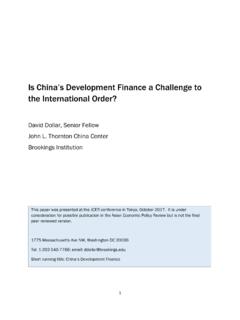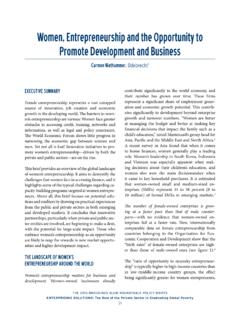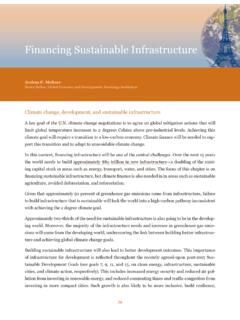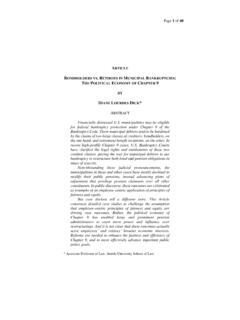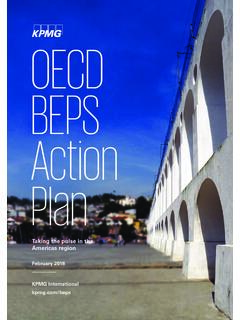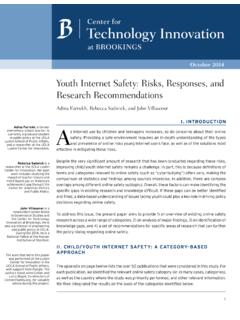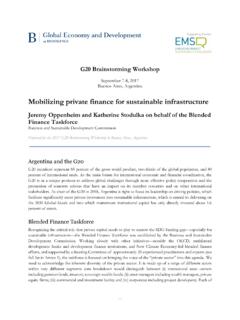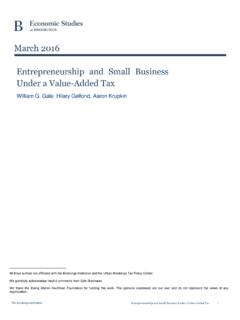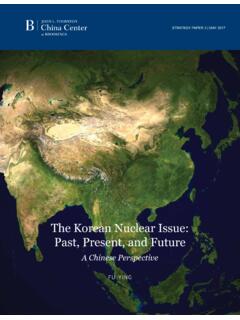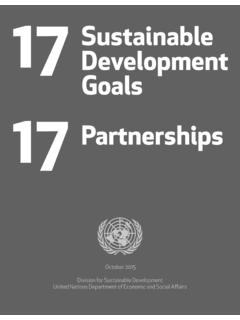Transcription of Trends and Issues in Development Aid - brookings.edu
1 WOLFENSOHN CENTER FOR Development . WORKING PAPER 1 | NOVEMBER 2007. Trends AND Issues IN. Development AID. Homi Kharas The brookings Global Economy and Development working paper series also includes the following titles: Wolfensohn Center for Development Working Papers Middle East Youth Initiative Working Papers Global Health Financing Initiative Working Papers Learn more at Homi Kharas is a Visiting Fellow at the Wolfensohn Center for Development at brookings . Author's Note: Excellent research assistance was provided by Joshua Hermias and Stephanie Brewer. CONTENTS. Executive Summary..1. Introduction .. 2. A Framework for Aid .. 3. Aid Trends .. 6. De nitions .. 6. Net aid ows the aggregates.. 6. Net aid transfers into country programmable aid (CPA) .. 7. Destination of aid.
2 10. Net aid ows multilateral agencies .. 11. Non-DAC aid donors .. 12. Private aid donors.. 13. Aid Architecture .. 15. Changes in aid architecture .. 15. Key Issues ..17. Information sharing, coordination and planning ..17. Results, effectiveness, and allocation rules .. 20. Scaling up, learning and innovation .. 23. A new dialogue .. 24. Endnotes .. 25. Trends AND Issues IN. Development AID. Homi Kharas EXECUTIVE SUMMARY Total aid ows to developing countries therefore currently amount to around $180 billion annually. T his note provides background data and analysis on what has been happening to aid flows and the resulting change in aid architecture. It is based on Key Trends in aid architecture data taken from the OECD/DAC and on a review of the Multilateral aid agencies (around 230) outnumber literature.
3 Donors and recipients combined. Multilaterals only disburse 12 percent of total aid (of cial plus private), and about one-quarter of total Key numbers on Development net CPA. assistance Trends Multilaterals disburse more towards Africa than do Net of cial Development assistance (ODA) from the bilaterals. 22 DAC member countries has increased to over $100 billion over the last two years, with a prom- The average number of donors per country is grow- ise of increases of 30 percent over the next three ing, while average project size appears to be shrink- years. ing, implying growing fragmentation of aid. Most ODA is for special purpose needs which do not translate into funds available for Development Key Issues projects and programs. Developing country govern- Mechanisms for information sharing, coordination, ments are only receiving about $38 billion in net planning and aid administration are increasingly country programmable aid (CPA).
4 Costly and ineffective. Sub-Saharan Africa is especially hard hit by this There is a growing need for ef cient allocation rules wedge between ODA and CPA. It only received $ for donors to fund the growing number of aid agen- billion in CPA in 2005, showing almost no increase cies, but assessments of aid agency effectiveness is over the preceding two decades. in its infancy. Non-DAC bilateral assistance (NDBA) is growing Scaling up, learning and innovation could advance rapidly and amounts to more than $8 billion in ODA as new players experiment with new methods, but and $5 billion annually in CPA. would require more public and private sector ex- changes. Private aid (PrA) from DAC member countries might already contribute between $58-68 billion per year, although aggregate data is sketchy.
5 Trends AND Issues IN Development AID 1. INTRODUCTION in 1985, in constant dollar terms. In terms of donor GDP or per capita support for recipient countries, the D evelopment assistance from rich countries (DAC. members) to poor countries topped US$100. billion in each of the last two years, a record high. amounts now going for long-term Development in SSA. have declined steadily for a generation. These gures compare with Development assistance This note documents the Trends in aid that have led of US$ billion in 1974 (expressed in constant to this result. It shows the growing reluctance of rich 2005 dollars) and US$ billion in 2001, before the countries to funnel their assistance in the form of Monterrey pledge to increase aid. program or project support to developing countries.
6 It shows that although the number of multilateral agen- On the face of it, these numbers show a remarkable cies has grown dramatically over time, the share of aid increase in Development assistance. But what lies passing through these channels has shrunk. It shows behind the numbers is less encouraging. A signi cant the growth in the number of specialized agencies, fraction of the increase has gone into debt forgive- each focusing on narrow developmental Issues at the ness for Nigeria and Iraq, and additional amounts expense of broader, more comprehensive strategies. have been allocated for unprecedented natural disas- And nally it shows that increases in aid are more ters and new disease burdens. likely to come from non-DAC bilateral donors, NGOs and new corporate philanthropists than through tra- The most pressing challenge of Development , the ef- ditional channels.
7 Fort to raise incomes of the poorest countries in sub- Saharan Africa (SSA), has hardly seen any funding Section II of this note describes a general framework increase at all. Astonishingly, our estimates suggest of aid ows, followed by a discussion on Trends in the that only $ billion of the overall of cial develop- volume of net aid ows in Section III. Section IV looks ment assistance takes the form of funds that SSA. at the changing aid architecture. Section V concludes countries can use to invest in social and infrastructural with Issues for discussion. Development programs. This is almost the same as the amount received by these countries twenty years ago 2 WOLFENSOHN CENTER FOR Development . A FRAMEWORK FOR AID could have one Development relationship with each recipient country.
8 This would be far simpler and more T he traditional aid framework connects three channels. Citizens in rich countries pay taxes to their governments, some of which are used for devel- ef cient than each donor having a relationship with each recipient In addition, the multilateral aid mobilization framework provided for effective opment assistance. These rich country governments burden sharing among donors, which contributed on-lend or grant money to poor country governments, to a sense of fairness, a spirit of competition among who in turn implement programs and policies designed donors in replenishment rounds and thus also contrib- to accelerate Development and reduce poverty. The uted to raising the general willingness to pay. framework works well when the public in rich coun- tries is willing to have tax revenues spent on aid, when This basic system, illustrated in Figure 1, worked well rich country governments have con dence in poor through the early 1990s.
9 It was exible enough to ac- country governments to develop appropriate projects commodate many new recipients, as countries gained and programs and when poor country governments independence, and many new donors. Indeed, as the have the capacity to implement these programs so as numbers of donors and recipients grew, the poten- to generate the desired developmental results. tial ef ciency gains from multilateralism also grew. Several regional multilateral agencies and the United During the Marshall Plan, which remains the best ex- Nations System also helped expand the reach and ample of external, of cial aid success, the channels scope of the multilateral network. were simple and effective. There was great public support for helping Europe get back on its feet.
10 A. Multilateral Agencies can act to reduce single major donor, the USA, provided funds to a small transaction costs and provide a coordination number of countries whose economies had been de- function for mobilizing and disbursing funds. stroyed by the war. The focus was on reconstruction, implying that Development projects were easily identi- In this framework, multilateral agencies have several able. Planning and implementation skills in recipient distinct functions. First, they act to reduce transac- countries were strong. tion costs and provide a coordination function for mobilizing and disbursing funds. If there are D donors A more complex picture emerged when efforts were and R recipients, then the number of one-to-one re- reoriented towards Development of poor countries.
